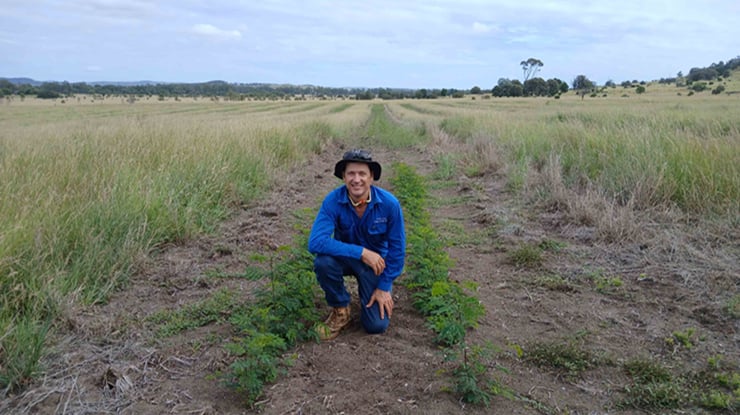 Stuart Barrett at his property ‘Drumburle’.
Stuart Barrett at his property ‘Drumburle’.
Productivity gains through pasture insights and genetics
Stuart and Katie Barrett have overcome productivity challenges in their breeding and backgrounding operations ‘Drumburle’, south of Biloela in Central Queensland.
By accessing historic forage mapping and the expertise available through MLA’s Northern Breeding Business (NB2) program, they solved the puzzle of grazing pressure inconsistencies in certain areas of their highly productive growing country.
Led by the Queensland Department of Primary Industries (QDPI), this NB2 pilot program involved producer groups across northern Australia.
Stuart has been part of the Fitzroy NB2 program since 2021 and took on the producer coordinator role for nine other grazing businesses involved.
Pasture insights improve productivity
The program’s skill-building activities unlocked key insights into why areas of the Barretts’ pasture were underutilised despite being located on heavier, more productive scrub soils.
Stuart used DPI’s Grazing Resilience and Sustainable Solutions (GRASS) program to access Drumburle’s historical ground cover percentages – it revealed clues on how to improve the feed quality in these areas.
He paired the historical data with on-ground observations. After purchasing land which had a valley with deep black soil, Stuart noticed his cattle were favouring soft natural grasses on higher ground and lighter land.
“The valley consistently had really good ground cover – you’d think the cattle would be down in the valley getting the best pasture from this soil, but they were actually up on the ridge,” Stuart said.
A closer look at pasture type revealed why.
“There’s an abundance of setaria species like purple pigeon grass and Biloela buffel growing there. They’re persistent and perennial but not particularly palatable.”
Chatting to other producers in the group revealed they had experienced similar issues with these species.
Eat your greens
Chatting to other producers in the group revealed they had experienced similar issues with these species.
“The valley’s 100ha of purple pigeon grass is hardy and provides lots of roughage, which cattle need when they’re consuming a lot of protein,” he said.
NB2 gave him confidence to plant 38ha of leucaena in February last year.
“If I hadn’t done the program, I wouldn’t have had the information required to make this strategic decision, which will improve our weight gains and productivity.”
He planted rows of leucaena every 10m, like hedgerows, as an economical way of putting protein into the pastures. In January – after nearly a year to give the leucaena time to establish – cattle were let in to start grazing.
“Combining the purple pigeon grass with the leucaena encourages them to eat enough roughage,” Stuart said.
“The leucaena is like eating ice cream off a tree so they’re going to want some roughage to go along with this rich diet.”
By combining these species, Stuart turned an undesirable species into something that works well as a pasture mix.
Jumping ahead with genetics
Stuart has made an additional profitable adjustment since his participation in NB2 by introducing Wagyu genetics into his Droughtmaster herd.
He drew on the genetic knowledge of a consultant, who provided him with information and confidence to implement a cross-breeding strategy within a portion of Drumburle’s herd.
The Barretts select high-marbling Wagyu bulls to cross with Droughtmaster cows.
“We were starting to get discounts on the feeder grid from the higher Bos indicus content, so crossing the Droughtmasters with Wagyu bulls will help reduce these. The Wagyu genetics also improved our fertility, temperament, and intramuscular fat and marbling,” Stuart said.
Reaping the rewards
This strategy has improved joining rates among Stuart’s yearling heifers – the first round of progeny from the Wagyu bulls joined two years ago. While his previous rate would have been four Droughtmaster bulls to cover 150 females, he reduced to three Wagyu bulls to 150 breeders.
“We’re a modest, family-sized operation and are affected by cost of production increases.
It’s difficult to increase production while you’re still being conservative with the environment,” Stuart said.
These environmental considerations include refraining from overgrazing and being conservative with their long-term decision making around stocking rates and seasonal variability.
“We’re trying to get a premium through increasing the Wagyu content. Next year we will have F2 calves on the ground and we’ll start seeing better eating quality.”
Better together
The Fitzroy NB2 group plans to keep meeting beyond the funding period of the program, which concluded at the end of June 2024.
“We want to take turns hosting group activities and get-togethers where we invite businesses and subject matter experts,” Stuart said.
The social aspect is also a drawcard, filling a gap experienced by many farming families in the area.
“I needed fresh ideas and the access to experts and fellow producers really helped when I was taking over the business from my father.
“Sometimes getting involved in these projects can lead to a bit of trepidation, but by the end of it, I was refocused, re-energised and am more motivated to go and actually try new things.”



